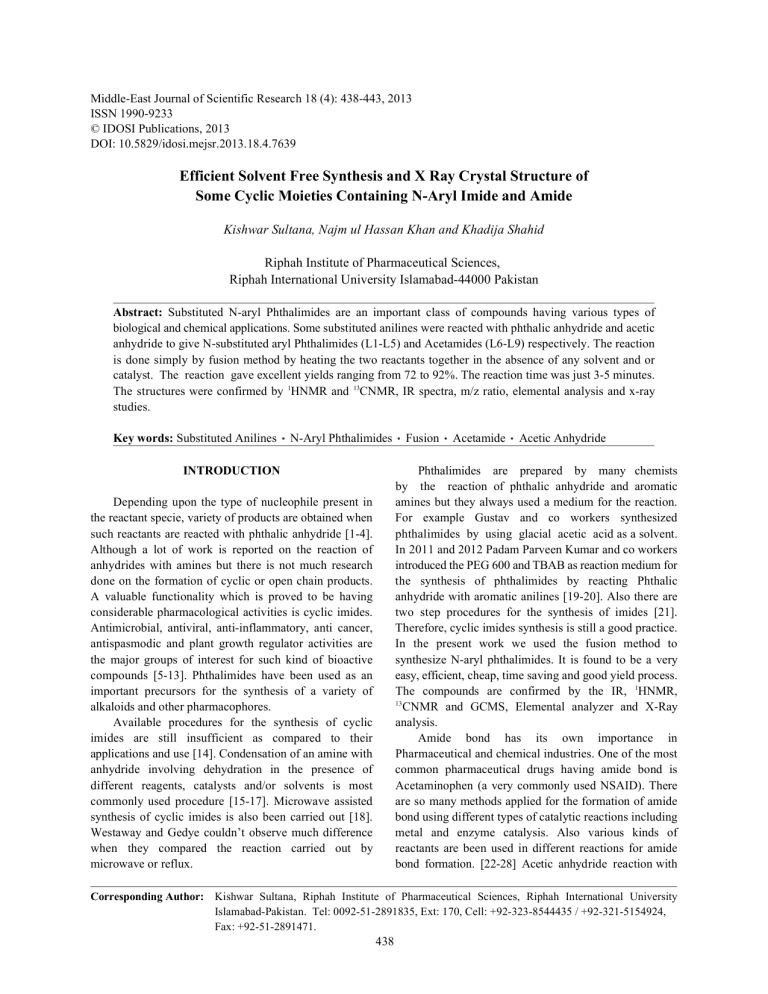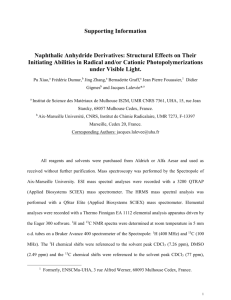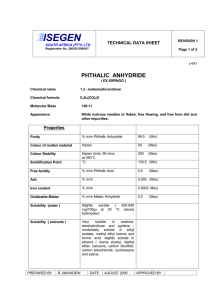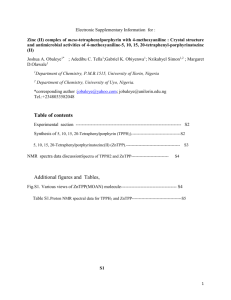Full Text

Middle-East Journal of Scientific Research 18 (4): 438-443, 2013
ISSN 1990-9233
© IDOSI Publications, 2013
DOI: 10.5829/idosi.mejsr.2013.18.4.7639
Efficient Solvent Free Synthesis and X Ray Crystal Structure of
Some Cyclic Moieties Containing N-Aryl Imide and Amide
Kishwar Sultana, Najm ul Hassan Khan and Khadija Shahid
Riphah Institute of Pharmaceutical Sciences,
Riphah International University Islamabad-44000 Pakistan
Abstract: Substituted N-aryl Phthalimides are an important class of compounds having various types of biological and chemical applications. Some substituted anilines were reacted with phthalic anhydride and acetic anhydride to give N-substituted aryl Phthalimides (L1-L5) and Acetamides (L6-L9) respectively. The reaction is done simply by fusion method by heating the two reactants together in the absence of any solvent and or catalyst. The reaction gave excellent yields ranging from 72 to 92%. The reaction time was just 3-5 minutes.
The structures were confirmed by HNMR and CNMR, IR spectra, m/z ratio, elemental analysis and x-ray studies.
Key words: Substituted Anilines N-Aryl Phthalimides Fusion Acetamide Acetic Anhydride
INTRODUCTION
Depending upon the type of nucleophile present in the reactant specie, variety of products are obtained when such reactants are reacted with phthalic anhydride [1-4].
Although a lot of work is reported on the reaction of anhydrides with amines but there is not much research done on the formation of cyclic or open chain products.
A valuable functionality which is proved to be having considerable pharmacological activities is cyclic imides.
Antimicrobial, antiviral, anti-inflammatory, anti cancer, antispasmodic and plant growth regulator activities are the major groups of interest for such kind of bioactive compounds [5-13]. Phthalimides have been used as an important precursors for the synthesis of a variety of alkaloids and other pharmacophores.
Available procedures for the synthesis of cyclic imides are still insufficient as compared to their applications and use [14]. Condensation of an amine with anhydride involving dehydration in the presence of different reagents, catalysts and/or solvents is most commonly used procedure [15-17]. Microwave assisted synthesis of cyclic imides is also been carried out [18].
Westaway and Gedye couldn’t observe much difference when they compared the reaction carried out by microwave or reflux.
Phthalimides are prepared by many chemists by the reaction of phthalic anhydride and aromatic amines but they always used a medium for the reaction.
For example Gustav and co workers synthesized phthalimides by using glacial acetic acid as a solvent.
In 2011 and 2012 Padam Parveen Kumar and co workers introduced the PEG 600 and TBAB as reaction medium for the synthesis of phthalimides by reacting Phthalic anhydride with aromatic anilines [19-20]. Also there are two step procedures for the synthesis of imides [21].
Therefore, cyclic imides synthesis is still a good practice.
In the present work we used the fusion method to synthesize N-aryl phthalimides. It is found to be a very easy, efficient, cheap, time saving and good yield process.
1 The compounds are confirmed by the IR, HNMR,
13 CNMR and GCMS, Elemental analyzer and X-Ray analysis.
Amide bond has its own importance in
Pharmaceutical and chemical industries. One of the most common pharmaceutical drugs having amide bond is
Acetaminophen (a very commonly used NSAID). There are so many methods applied for the formation of amide bond using different types of catalytic reactions including metal and enzyme catalysis. Also various kinds of reactants are been used in different reactions for amide bond formation. [22-28] Acetic anhydride reaction with
Corresponding Author: Kishwar Sultana, Riphah Institute of Pharmaceutical Sciences, Riphah International University
Islamabad-Pakistan. Tel: 0092-51-2891835, Ext: 170, Cell: +92-323-8544435 / +92-321-5154924,
Fax: +92-51-2891471.
438
Middle-East J. Sci. Res., 18 (4): 438-443, 2013 aniline is one of them. In the present study we are introducing the simplest method for the synthesis of various phenyl substituted acetamides.
RESULTS AND DISCUSSION
In the present study we prepared different kinds of
N-aryl substituted Phthalimides and N aryl Acetamides by using the simplest and solvent free method. First we performed the fusion reaction of phthalic anhydride with different substituted anilines. We get a good yield of the compound with comparable melting points.
The physical properties of compounds are listed here in the Table 1.
Initially we were expecting an open chain structure of carboxylate but the characterization confirmed the presence of cyclic imides. FTIR spectrum of L1-L5 proves the cyclic structure of imides as there are no absorption
(N-H) dehydration and formation of 5 membered ring containing
Nitrogen.
Also the two bands near 1780 cm-1 and 1708 cm-1 represent the asymmetric and symmetric carbonyl bands of cyclic imides. Moreover in the HNMR spectra the two different multiplet signals at (7.07-7.55) and (7.80- 7.98) ppm represent the protons of two different aromatic rings.
13
1HNMR spectrum of compound L4 showed a distinct singlet at 2.43 ppm for the H of para methyl (CH3) group and two multiplets at =7.33 and 7.18 ppm belong to protons of the two aromatic rings. There are no peaks for
NH or OH which confirms the presence of 5 membered ring.13CNMR spectrum for L4 showed signal peaks at 20.8
and 167 for C of para methyl and C=O of imide ring.
The signals for both aromatic rings lie in between
(126-137) ppm. Further confirmation was done by elemental analysis.
In the second trial we synthesized amides by reacting acetic anhydride with anilines by fusion of the reactants through heating without use of any solvent or catalyst. We got good yield N-aryl acetamides which are further purified by recrystallization using chloroform.
Melting points and Infra Red spectra were analogous with the literature. Further characterizations confirmed the structures assigned. X-ray structure of N- (2methylphenyl) acetamide is also been resolved.
1 HNMR spectrum of compound L7 showed two distinct singlet at = 2.23 and 3.91 ppm for (O=C-CH3) and (O-CH3) respectively. A multiplet at = (6.98-7.06) ppm belongs to protons of the aromatic ring. There is
13
CNMR spectrum also complies well with the structures and 168.9 ppm for CH , O-CH and C=O respectively.
assigned. GCMS data further confirms the structure and purity of compounds.
peak for NH at 7.78 ppm. CNMR results verified the structure of the compound L7. A distinct signal at 24, 55.8
The signals for aromatic ring appeared between (109-147) ppm.
3 3
Table 1:
S # Anhydride
6
7
8
9
4
5
1
2
3
Phthalic anhydride
Phthalic anhydride
Phthalic anhydride
Phthalic anhydride
Phthalic anhydride
Acetic anhydride
Acetic anhydride
Acetic anhydride
Acetic anhydride
Physical aspects of compounds
Aniline
C H NH
2
C H N H
2
Product Code (Empirical formula) %Yield
85
92
79
75
78
72
89
90
85
Reaction time (min)
3
3
4
4
2.5
3
3
3.5
3
M.P (°C)
199-202
174-175
143-145
191-194
149-155
118
68
98
180
Fig. 1:
439
1
Middle-East J. Sci. Res., 18 (4): 438-443, 2013
HNMR spectrum of compound L8 showed two distinct singlet at = 2.22 and 2.28 ppm for (O=C-CH ) and (-CH ) respectively. A multiplet at = (7.10-7.24) ppm
3 belongs to protons of the aromatic ring. There is peak for
NH at 7.78 ppm. CNMR results verified the structure of the compound L8. A distinct signal at 17.3, 23.93 and
167.98 ppm for CH , carboxy CH and C=O respectively.
The signals for aromatic ring appeared between
(123-136.2) ppm.
Crystal Structure
2-phenyl-1H-isoindole-1,3(2H)-dione L1 : Yield: 89%, m.p.: 199-202°C (lit. 199-201 °C), IR: 1778, 1707, 1592, 1464,
1282 cm . H NMR 400 MHz (CDCl , ppm): 7.98 (dd), 7.83
13
3
(dd), 7.54 (m), 7.43 (m). CNMR (CDCl , ppm): 131.4 (1,1’),
3
123.4 (2, 2’), 131.4 (3, 3’), 166.9(4, 4’), 134 (5), 127.7(6),
128.7 (7), 126.2 (8), 128.7 (9), 127.7 (10). m/z 223 [M],
179, 104, 76.
Fig. 2: ORTEP diagrams for compound L8. Thermal ellipsoids are shown at the 50% probability level.
Hydrogen atoms are omitted for clarity.
13 CNMR (CDCl , ppm): 132.5 (1,1’), 123.7 (2, 2’), 132.5 (3,
3’), 166.5 (4, 4’), 129.7 (5), 131 (6), 130.7 (7), 123.5 (8), 122
(9), 134.9 (10). m/z 303 [M ],, 257, 207, 197, 178, 166, 151,
104, 90, 76, 67, 57.
2-(2-methylphenyl)-1H-isoindole-1,3(2H)-dione L2 :
Yield: 90%, m.p.: 174-175 °C (lit178-180 °C), IR: 1781, 1706,
1590, 1461, 1377 cm . H NMR 400 MHz (CDCl , ppm):
3
7.97 (dd), 7.83 (dd), 7.39 (m), 7.28 (m), 2.23 (s). CNMR
(CDCl , ppm): 130.2 (1,1’), 123.4 (2, 2’), 131 (3, 3’), 167
3
(4, 4’), 131 (5), 126.5 (6), 128 (7), 129 (8), 133.9 (9),
136 (10), 17.7 (11). m/z 237 [M ],, 219, 193,180, 165, 104, 89,
76, 50.
2-(4-methoxyphenyl)-1H-isoindole-1,3(2H)-dione L3 :
Yield: 85%, m.p.: 143-146 °C (lit. 143-145 °C), IR: 1781, 1701,
1609, 1514, 1386, 1250 cm . H NMR 400 MHz (CDCl ,
3 ppm): 7.96 (dd), 7.81 (dd), 7.35 (m), 7.05 (m), 3.87 (s).
13 CNMR (CDCl , ppm): 133.9 (1,1’), 123.3 (2, 2’), 133.9
3
(3, 3’), 167.1 (4, 4’), 128.8 (5), 114.5 (6), 158.9 (7), 114.5 (8),
128.8 (9), 125 (10), 55.8 (11). m/z 253 [M ],, 238, 210, 182,
130, 106, 76, 63, 50.
N- Phenylacetamide L6 : Yield: 79%, m.p.: 118 °C (lit.
116.5-118 °C), IR: 3291(N-H), 1661 (C=O), 1596, 1486
(aromatic C=C), 745 & 692 (mono substituted) cm . H
NMR 400 MHz (CDCl , ppm): 7.11(t), 7.31 (t), 7.51(d),
2.17(s), 7.96 (s)representing NH. CNMR400 MHz (CDCl , ppm): 137 (1), 119 (2,6), 123 (3,5), 128.5 (4), 168.4 (7),
N-(2-methoxyphenyl) Acetamide L7 : Yield: 75%, m.p.: 68
°C (lit. 71-93), IR: 3245(N-H), 1654 (C=O), 1595, 1494
(aromatic C=C), 746 (ortho substituted) cm . H NMR 400
MHz (CDCl , ppm): 6.98-7.06 (m), 7.78(s), 3.91(s), 2.23 (s).
13 CNMR 400 MHz (CDCl , ppm): 127 (1), 147 (2), 109 (3),
123 (4), 120 (5), 119 (6), 167 (7), 24 (8) 55.8 (9). m/z: 165
2-(4-methylphenyl)-1H-isoindole-1,3(2H)-dione L4 :
Yield: 85%, m.p.: 191-194 °C (lit.190-192 °C), IR: 1745, 1707,
1601, 1513, 1381, 1245 cm . H NMR400 MHz (CDCl ,
3 ppm): 7.96 (dd), 7.81 (dd), 7.33 (m), 7.18 (m), 2.43 (s).
13 CNMR (CDCl , ppm): 133.9 (1,1’), 123.3 (2, 2’), 133.9
3
(3, 3’), 167 (4, 4’), 126 (5), 129 (6), 137.8 (7), 129 (8), 126 (9),
131 (10), 20.8 (11). m/z 237 [M ], 193, 165, 104, 76, 50. Anal.
15 11 2
C, 74.0; H, 4.74; N, 5.67.
2-(3-bromophenyl)-1H-isoindole-1,3(2H)-dione L5
Yield: 92%, m.p.: 149-155 °C (lit. 148-150 °C), IR: 3064, 1778,
1708, 1593, 1540, 1423, 1377, 1068 cm . H NMR 400 MHz
:
N- (2-methylphenyl) acetamide L8 : Yield: 78 %, m.p: 98°C
(lit. 98-101 °C), IR: 3289(N-H), 1641 (C=O), 1587, 1457
(aromatic C=C), 747 (ortho substituted) cm . H NMR 400
MHz (CDCl , ppm): 7.0-7.30 (m), 7.76(s), 2.28 (s), 2.22 (s).
13 CNMR 400 MHz (CDCl , ppm): 135.2 (1), 130.6 (2), 128.9
3
(3), 126.3 (4), 124.9 (5), 123 (6), 168 (7), 23.9 (8) 17.4 (9). m/z:
149 [M ], 107, 91, 77, 43.
Crystal data: CCDC 948447
Fig 2: ORTEP diagrams for compound 3D. Thermal ellipsoids are shown at the 50% probability level.
Hydrogen atoms are omitted for clarity.
440
Middle-East J. Sci. Res., 18 (4): 438-443, 2013
Table 2: Bond Lengths
C(2)-C(3)
C(2)-C(1)
C(2)-C(9)
C(1)-C(6)
C(1)-N(1)
1.390(3)
1.393(3)
1.508(3)
1.395(3)
1.428(3)
C(3)-C(4)
C(7)-O(1)
C(7)-N(1)
C(7)-C(8)
C(6)-C(5)
C(5)-C(4)
1.390(3)
1.237(3)
1.349(3)
1.498(3)
1.386(3)
1.386(3)
Bond Angles
C(3)-C(2)-C(1)
C(3)-C(2)-C(9)
C(1)-C(2)-C(9)
C(2)-C(1)-C(6)
C(2)-C(1)-N(1)
C(6)-C(1)-N(1)
C(4)-C(3)-C(2)
117.99(19)
120.78(19)
121.23(18)
120.77(19)
119.48(18)
119.75(18)
121.7(2)
O(1)-C(7)-N(1)
O(1)-C(7)-C(8)
N(1)-C(7)-C(8)
C(5)-C(6)-C(1)
C(4)-C(5)-C(6)
C(5)-C(4)-C(3)
C(7)-N(1)-C(1)
122.9(2)
121.04(19)
116.10(17)
120.2(2)
119.70(19)
119.61(19)
123.72(17)
Selected bond lengths [$A] and Bond angles [deg.] for compound 3D
Scheme II (Synthesis of Acetamides)
Structures of Ligands (Figure 3)
Selected bond lengths and bond angles are illustrated in Table 2.
N-(4-methylphenyl) acetamide L9 : Yield: 72%, m.p.: 180
°C (lit.185 °C), IR: 3297 (N-H), 1662 (C=O), 1600, 1505
(aromatic C=C), 830 (para substituted) cm . H NMR 400
MHz (CDCl , ppm): 7.14(dd),7.40 (dd), 7.28(s), 2.33(s), 2.17
(s). CNMR 400 MHz (CDCl , ppm): 133.5 (1), 119.6 (2),
129 (3), 134.9 (4), 129 (5), 119.6 (6), 167.8 (7), 24 (8) 20.5 (9).
MATERIALS AND METHODS
General Procedure for Synthesis of Ligands:
1mMol of anhydride and 1m Mol of substituted aniline were weighed accurately and separately. The compound having low melting point was taken in the
China dish and started heating, as soon as the solid get melted (in case of liquid just heated not boiled), the other reactant was then added with continuous stirring.
The reaction may evolve some fumes and may change the color and phase. Then heated for a while until a homogenous phase formed, allowed to cool at room temperature. The product obtained is recrystallized by using chloroform.
Schemes 1and 2 describe the general reaction for L1-
L5 and L6-L9 respectively.
Scheme 1 (synthesis of N-Aryl Phthalimides)
CONCLUSION
The synthesis of N-aryl phthalimides and phenyl acetamides is even possible in the absence of solvents, any other medium or catalyst, just heating and fusion of reactants is required.
ACKNOWLEDGEMENT
Higher Education Commission of Pakistan is highly appreciated for the financial support. We are also grateful to Department of Chemistry,
University of Montreal Canada for analysis of compounds.
Supporting Information: Complete details of the
X-ray analysis for compound N4 have also been deposited at the Cambridge Crystallographic Data
Centre (CCDC) and can be retrieved with the following reference number: 948447. These data can be obtained free of charge via www.ccdc.cam.ac.uk/ data_request/cif, by emailing data_request@ccdc.
cam.ac.uk, or by contacting The Cambridge
Crystallographic Data Centre, 12, Union Road,
Cambridge CB2 1EZ, U.K. (fax: +44 1223 336033).
441
REFERENCES
1. Wang, C.H., R. Isensee, A.M. Griffith and
B.E. Christiansen, 1947. The Preparation of 3,3-
Dimethylphthalide and Several of its Derivatives
Journal of American.Chemical Society, 69: 1909-1911.
2. Wilson, J.M., 1951. The action of organo-lithium compounds on some esters and anhydrides of dicarboxylic acids. Journal of Chemical Society, pp: 2297-2299.
3. Mohiuddin, S.M.G., 1994. Reactions of Phthalic
Anhydride with Certain Nucleophiles, M.Phil. Thesis,
J.N.T. University, Hyderabad, Pakistan.
4. Dubey, P.K., S.M.G. Mohiuddin and D. Ramesh, 1997.
Reactions of phallic anhydride. Asian Journal of
Chemistry, 9: 379-387.
5. Lima, E.O., E.F. Queiroz, A.D. Andricopulo,
R.J. Nunes, R.A. Yunes, R. Correa and V. Cechinel-
Filho, 1999. Evaluation of antifungal activity of
N -arylma-leimides and N-phenylalkyl-3,4dichloromaleimides. Boletín de la Sociedad Chilena de
Química, 44: 185-189.
6. Lopez, S.N., M. Sortino, A. Escalante, F. De Campos,
R. Correa, V. Cechinel Filho, R.J. Nunes and
S.A. Zacchino, 2003. Antifungal properties of novel
N- and a,b –substituted succinimides against dermatophytes. Arzneim. Forsch./ Drug Res.,
53: 280-288
7. Borchnard, D.M., A.D. Andricopulo, CoMFA and
CoMSIA, 2009. 3D QSAR models for a series of cyclic imides with analgesic activity. Medicinal
Chemistry, 5: 66.
8. Machado, A.L., L.M. Lima, J.X. Arau´jo Jr, C.A.M.
Fraga, V.L.G. Koatz and E.J. Barreiro, 2005. Design, synthesis and antiinflammatory activity of novel phthalimide derivatives, structurally related to thalidomide. Bioorganic Medicinal Chemistry Letters,
15: 1169.
9. Alaa, A.M. and A. Abdel, 2007. Novel and versatile methodology for synthesis of cyclic imides and evaluation of their cytotoxic, DNA binding, apoptotic inducing activities and molecular modeling study.
European Journal of Medicinal Chemistry, 42: 614.
10. Kenji, S., N. Hideko, U. Yoshihiro, S. Yoshikazu,
N. Kazuharu, W. Motoji, W. Konstanty, T. Tadafumi,
A. Tetsuji, Y. Yuji, K. Kenji and H. Hitoshi, 2005.
Napthalimidobenzamide DB-51630: A novel DNA binding agent inducing p300 gene expression and exerting a potent anti-cancer activity. Bioorganic
Medicinal Chemistry, 13: 4014-4021.
Middle-East J. Sci. Res., 18 (4): 438-443, 2013
11. Sabata, Y., M. Shichita, K. Sasaki, Y. Hashimoto and
S. Iwasaki, 1995. N-Alkylphthalimides: structural requirement of thalidomidal action on 12-Otetradecanoylphorbol-13-acetate-induced tumor necrosis factor alpha production by human leukemia
HL-60 cells. Chemical and Pharmaceutical Bulletin,
43: 177.
12. Miguel, F.B., D. Gema, S. Beatriz, R. Cynthia,
R. Simmon and B. Teresa, 2002. Synthesis and antitumour activity of new dendritic polyamines-
(imide-DNA-intercalator) conjugates: potent Lck inhibitors. European Journal of Medicianl Chemistry,
37: 541.
13. Miyachi, H., A. Azuma, A. Ogasawara, E. Uchimura,
N. Watanabe, Y. Kobayashi, F. Kato, M. Kato and
Y. Hashimoto, 1997. Novel biological response modifiers: phthalimides with tumor necrosis factor-a production- regulating activity. Journal of Medicinal
Chemistry, 40: 2858-2865.
14. Walker, M.A., 1994. The Mitsunobu Reaction: A
Novel Method for the Synthesis of Bifunctional
Maleimide Linkers. Tetrahedron Letters,
35(5): 665-668.
15. Da Settimo, A., G. Primofiore, F. Da Settimo,
F. Simorini, A. Martinelli and E. Boldrini, 1996.
European Journal of Medicinal Chemistry, 31: 49.
16. Reddy, P.Y., S. Kondo, T. Toru and Y. Ueno, 1997.
Lewis Acid and Hexamethyldisilazane-Promoted
Efficient Synthesis of N-Alkyl- and N-Arylimide
Derivatives. Journal of Organic Chemistry, 62: 2652.
17. Kunieda, T., T. Nagamatsu, T. Higuchi and
M. Hirobe, 1988. Highly efficient oxazolone-derived reagents for beta-lactam formation from beta-amino acids. Tetrahedron Letters, 29: 2203-2205.
18. Mei- Yun, Z., Yi-Qun, L. and Xin-ming Xu, 2003. A new simple and efficient synthesis of N-aryl
Phthalimides in ionic liquid [bmim][PF6]. Synthetic
Communications, 33: 3777-80.
19. Kumar, P.P., D.B. Rama, P.K. Dubey and
S.M. Mohiuddin, 2011. PEG-600 mediated simple, efficient and eco-friendly synthesis of N-substituted imides and chemo selective C =C reduction. Green
Chemistry Letters and Review, 4: 341-348.
20. Kumar, P.P., D.B. Rama and P.K. Dubey, 2012. An
Easy and Efficient Synthesis of N-Substituted Imides
Using TBAB Melt as Neutral, Cost-Effective and
Recyclable Ionic Liquid. Current Catalysis, 1: 202-205.
21. Al-Azzawi, A. and M.S.A. Razzak, 2011. Synthesis,
Characterization and antibacterial activity of Several
New Schiff Bases Linked to Phthalimide Moiety.
Journal of. Pharmaceutical Sciences, pp: 312-320.
442
Middle-East J. Sci. Res., 18 (4): 438-443, 2013
22. Pattabiraman, V.R. and J.W. Bode, 2011. Rethinking amide bond synthesis. Nature, pp: 471-480.
23. Soule, J.F., H. Miyamura and S. Kobayashi, 2011.
Powerful amide synthesis from alcohols and amines under aerobic conditions catalyzed by gold or gold/iron, -nickel or -cobalt nanoparticles Journal of
American Chemical Society, 133: 185.
24. Yamaguchi, K., H. Kobayashi, T. Oishi and
N. Mizuno, 2011. Heterogeneously catalyzed synthesis of primary amides directly from primary alcohols and aqueous ammonia, Angewandte Chemie
International Edition in English, 51: 544.
25. Allen, C.L., A.R. Chhatwal and J.M.J. Williams, 2012.
Direct amide formation from unactivated carboxylic acids and amines Chemical Communication,
48(5): 666-8.
26. Constable, D.J.C., P.J. Dunn, J.D. Hayler, G.R.
Humphrey, J.L. Leazer, R.J. Jr., Linderman, K. Lorenz,
J. Manley, B.A. Pearlman, A. Wells, A. Zaks and
T.Y. Zhang, 2007. Key green chemistry research areas
– a perspective from pharmaceutical manufactureres.
Green Chemistry, 9: 411-420.
27. Roughley, S.D. and A.M. Jordan, 2011. The medicinal chemist's toolbox: an analysis of reactions used in the pursuit of drug candidates. Journal of Medicinal
Chemistry, 54: 3451-79.
443




